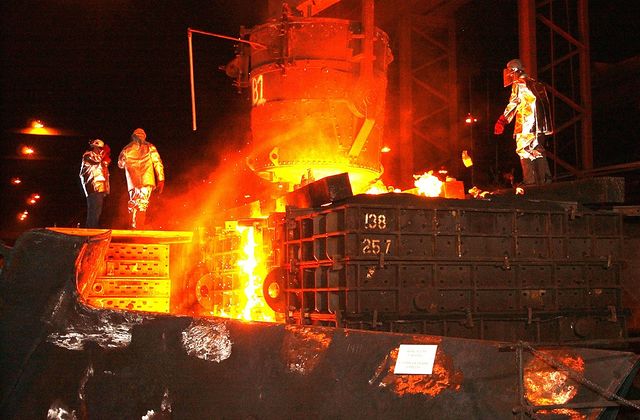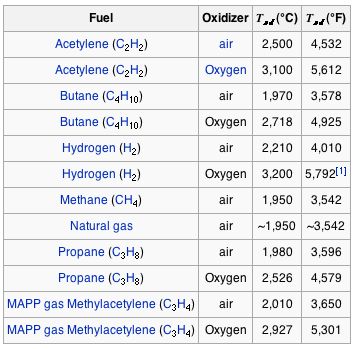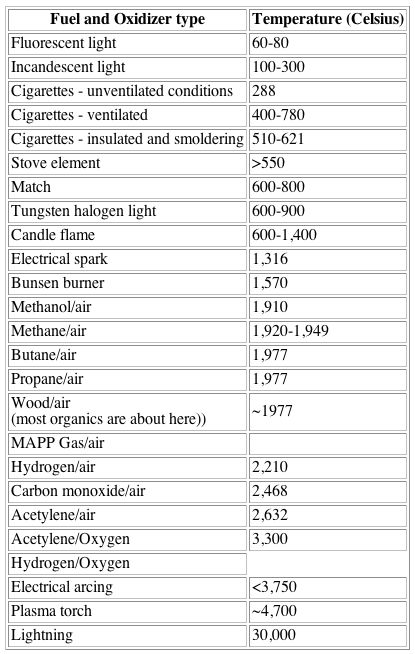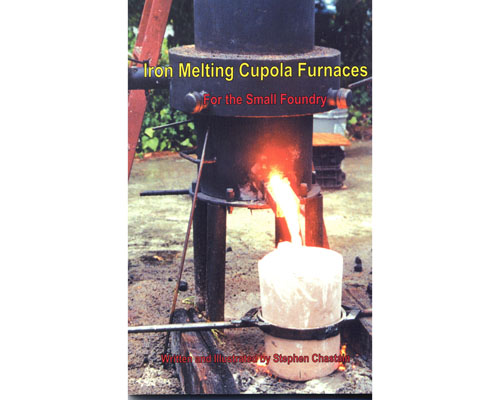Foundry
Main > Digital Fabrication > RepLab Tools > Induction furnace
Overview
A foundry is useful for converting otherwise unusable scrap metal into useful metal parts by melting the metal and casting it into desired shapes.
Research
- Steel melts at around 2,500 °F (1,370 °C) or slightly below pure iron
- Iron melting point - 2,800 °F (1,540 °C), 1811K
- Cast iron melting point - 1,150 °C (2,100 °F) to 1,200 °C (2,190 °F), about 300 °C lower than pure iron
- From [1]:
- Steel is iron and up to 2.0% carbon without any other alloying elements
- Above 2.0% C we are dealing with cast iron. Cast iron tends to be brittle, unless it is ductile cast iron.
- The steel melting point varies between 1,540 °C (2,800 °F) and 1,400 °C (2,550 °F), gradually declining with increasing carbon content.
There are a variety of heating techniques used to get steel hot enough to melt, including:
- fuel burning
- electric induction heating
- electric microwave heating
- electric arc heating
- concentrated solar
Alloying
In a small induction foundry it may be practical to economically produce alloy steels for lathe cutting tools, ironworker punch tools and dies, etc.
Need to find suppliers for small quantities of alloying elements. Try [2],[3] (more research needed). For high performance steel, contaminants in the scrap must be watched for and their influence controlled (often they can be removed through slag treatment in the furnace). Some elements are particularly hard to remove (e.g. copper, tin, nickel, chromium) and it would be good to be able to test for these in incoming scrap.
heating techniques
Heat Requirement Calculations
- Based on the specific heat of iron and its melting temperature, the energy requirements for meling iron are calculated:
- Converting this to fuel requirements based on the energy content of fuels for a give weight of fuel, we can calculate the amount of fuel required for melting. Heat losses such as total inefficiencies of heat transfer to the metal need to be included:
One source claims a production capacity of 700 lb/hour in a 175kW furnace.[1]
- Based on this explicit value, basic extrapolation can be done to figure out the amount of fuel required to provide this heat via simple burning. If LifeTrac burns under 1 gallon of fuel per hour, and it has a total energy use (including thermal waste) of about 100 kW, this indicates that about 2 gallons per hours should suffice to produce 700 of steel per hour. Given inefficiencies - say 50% heat transfer - we should produce 350 lb of steel per hour if we burned fuel for direct heat. The basic figure that arises is about 1 pound of fuel to 20 pounds of melted iron.
fuel burning foundry
- Flame temperatures from Wikipedia:
- Flame temperatures from [4]:
"Oil fired furnace Vs. Small cupola" by Lionel Oliver II says that "melting iron in a crucible with a waste oil burner and melting iron in a cupola with coal or coke ... Overall these two methods are the most practical and economical ways for a hobbyist to melt iron."
Is the "$30 Micro Forge" big enough to be useful?
Plans
Using coke as fuel: "Iron Melting Cupola Furnaces for the Small Foundry" by Steve Chastain [5]
Building a Cupola Furnace from loose scrap parts: "Building a Cupola"
- Plans for a 330 lb/hour iron melting foundry - [6]:
Building a cupola link takes me to a site for online dating?
Is there a way to do an oil-fired steel-melting furnace?
Would a Babington Burner work? Does this work? http://thesteelyard.blogspot.com/2008/06/waste-oil-fired-furnace-for-bronze-iron.html
- Oil-fired foundry on Instructables - [7]
induction heating foundry
See the Open Source Induction Furnace Project.
The Induction Furnace, aka induction heating foundry.
- College foundry, 100 lb steel or iron, 100 kW induction furnace - [8]
- Induction Furnace - 40 kW - http://www.ufes.com/index.php?n=Foundry.InductothermInductionFurnaceModel40-96
- Induction furnace - 75 kW, 112kg/hr steel, 25/50/100kg crucible, 1-3kHz, 775kWh/ton steel Agni Electrical, India
- Induction 4000 lb for 100kW, or 1000 lb for 25 kW? - [9]
- Induction furnaces are well- established for the melting and holding of iron, steel, aluminum, zinc, brass, and copper. High efficiency and the ability to precisely control the rate of heat input make this electric-based technology fully competitive with alternative direct-fired processes in many applications. New developments in variable-fre- quency power supplies, improved refractory linings, high-power inductor designs, furnace heat recovery, and computer control of furnace operations offer the potential for further significant improvements in furnace effi- ciency, productivity, and in the range of materials to which - excellent overview in EPRI Center for Materials Production.
- Another overview by Fairchild Semiconductor Power Division - [www.fairchildsemi.com/an/AN/AN-9012.pdf]
- Efficiencies of induction melters is 55-75% - [10]
microwave heating foundry
- Microwave melting - even iron - [11]
- Other technology: With the right techniques, a microwave oven can apparently heat glass to its melting point of 1,500 °C. ( PopSci, Wired, Howto). That is slightly more than melting point of steel (more or less 1,400 °C). Is it possible to use similar techniques to form small steel parts in a off-the-shelf microwave?[12] Would a thin layer of glass floating on the molten steel help block oxidation?
- I read this article. [Smelting in a Microwave]
concentrated solar foundry
"The maximum temperature the absorber can reach depends on how concentrated the sunlight is. A very high quality dish reflector could concentrate sunlight up to 10,000 times. If ordinary sunlight can heat things up to say 60 C (330 K) and the radiated energy rises as a power of 4, such as reflector could produce temperatures 10 times this, 3300 K or 3000 C. At the maximum temperature the absorber is radiating as much energy as it receives, leaving no energy available to be converted into anything useful like electricity! To actually get anything out of the concentrator we need the temperature of the absorber to be lower."[13]
For this reason, Solar Concentrators designed to produce electricity operate at much lower temperatures, and in fact typically have large radiators in order to keep them from getting "too hot" -- a very different design approach than a solar furnace. Is it possible to adapt the Solar Turbine Prototype at Factor e Farm to switch back and forth from directly melting metal in a crucible to generating electricity? Or is a solar turbine so very different from a solar furnace that it would be better to build a completely separate solar furnace?
Several Solar Concentrators arrangements appear capable of reaching temperatures high enough to melt iron and steel.[14] [15]
In theory, the maximum possible temperature of a solar foundry is the same as the temperature of the "surface" of the sun, 5,777 K. [16]
"The largest solar furnace in the world is at Odeillo in the Pyrenees-Orientales in France, opened in 1970. ... an area the size of a cooking pot ... can reach 3,500 °C (6,330 °F)" -- Wikipedia: solar furnace
"Why go to the trouble of building a solar array ... just for melting metal, when you can install a steam turbine and generate and sell electricity?" -- Tim Williams[17]. Some advantages of melting metal directly in a solar furnace, rather than indirectly converting solar power to electricity with a Solar Turbine and then using electric-powered foundry:
- Because a crucible is inherently simpler than a steam engine, it is simpler to build and maintain and lasts longer.
- Because a crucible has very easy tolerances, its capital cost is far less than a steam engine and any kind of electric-powered foundry. (Although it may require more expensive reflectors...)
- a solar furnace is easier to understand, replicate, and scale up or down.
electric arc furnace
- Arc furnace, 175kW, 700 lb/hour [1]
- ARC, 53kW, 560 lb - [18]
electroslag furnace
Electroslag remelting is complementary to the induction furnace because it specifically supports refining reactions which occur in the slag (for example removing sulfur, non-metallic oxides, and free oxygen). Example commercial scale equipment from Consarc. A very interesting family of mini-foundry products is offered by Centroteh (Ukraine). Conventionally, a previously melted and cast ingot rod from another type of furnace is fed into the top of an electroslag remelter. However Centroteh suggests that, alternatively, a fixed carbon electrode can feed the heating current and chopped scrap can be fed directly into the slag pool. Very interesting!! Could this replace the primary function of the induction furnace in turning scrap into new steel?
Electrical energy consumption is listed by Centroteh as ~320 watt-hr/lb, which is comparable to an induction furnace. The electroslag furnace does not seem to require refractory, as the process is performed directly in a water-cooled copper mold.
Reversion
Reversion refers to substituting know how, raw materials, and labor for off-shelf products. Using this technique, we can make steel-melting crucibles, to reduce costs. Crucibles for 300 pound shots are several hundred dollars. The materials cost about 10x less.
Crucibles
See also Induction Furnace Crucible
Getting the scrap metal into a cold crucible is the easy part. How do you get the molten metal out of the hot crucible?
- 200 lb dip out furnace for sale - [19]
- 3000F rocker furnace for sale, 750 lb per hour after first heat - electric with 2 electrodes - [20]
Crucibles are made from special clays.
- What is the composition?
- Portland cement, silica sand, perlite and fireclay.[21]
- Where do we procure the materials?
- How do we make the crucible?
- What is the total cost?
Collaboration Discussions
Letter sent to Paul
Could you do a little research on foundries? I put initial info up at:
http://openfarmtech.org/index.php?title=Foundry
We want to melt metal - to cast tractor, steam engine, and CEB press parts. We would like to do that this year. Are you by any chance interested in getting involved in this? The workshop will house the furnace.
If so, please research this and propose the best furnace to use. We want to work with steel - so any iron melting furnace will do. We are looking for a simple, low-cost design that can handle at least 200 pounds per hour, to be effective in casting - say the 2000 lb of a tractor frame - in one day.
The economics involved are producing $1000+ worth of structural steel for parts. This would make it economically feasible to produce tractors, etc - starting from scrap steel.
This would be quite a treat, to show fabrication starting at the cost of scrap metal. It's a possibility, but so far I have not seen an integrated operation that designs, casts, and builds under one roof. There is great potential for efficiency through this process, especially if we have global design sharing, and 3D printing of mold via open source printers such as RepRap. -Marcin
Input From Yahoo Home Foundry Group:
From Mikey
The method you need to employ isn't a matter of getting the furnace hot enough at all. Take a minute and absorb that basic fact, for steel melts between twenty-six and twenty-eight hundred degrees. Now consider the fact that the even higher furnace temperatures needed to bring a charge up to that range will destroy all but the most expensive furnace refractories, while weakening crucibles to the point where they become rubbery..Iron, on the other hand, melts nicely between nineteen-fifty and twenty-two hundred degrees; a much more comfortable heat range for your equipment.
So, how did industry turn iron into steel about a hundred years back? An oxygen lance was used to burn out excess carbon while simultaneously raising the molten iron to steel liquefying temperatures from the center of the charge, instead of trying to transfer overwhelming temperatures through crucible walls.
Most steel making still uses one form or another of heating steel charges from the center out.
I believe oxygen lances are still the best method for home hobbyists today.
As to Babington burners; I mostly dislike commenting on the competition.
From Venkat
Marcin, it is very difficult to melt steel ic oil :gas fired furnace because its melting temp is high as 1500 DEG CENTIGRADE, so pl try with induction of arc furnace only , steel needs some alloying elements like carbon , silicon, etc depending on its usage , you can try to build home made inaction melter, as some ref may be available in intranet, that is the way as for i concerned, Best regards, V;Ganesan;
Books
- Metallurgy of Iron and Steel - [22]
- Google Book, Maximum Production in Machine-shop and Foundry - 150 lb shots in 1911 foundry took 3.5 hours - with noted low production - [23]
- Google Book, The Foundry, early 1900s, has economics - [24]
- Principles of Foundry Technology, Google Book - [25]
See Also
- ↑ 1.0 1.1 Detroit Rocking ARC Furnace Model LFYP: capacity: 700 LBS serie, 175 KW, 440V, 60 HZ



